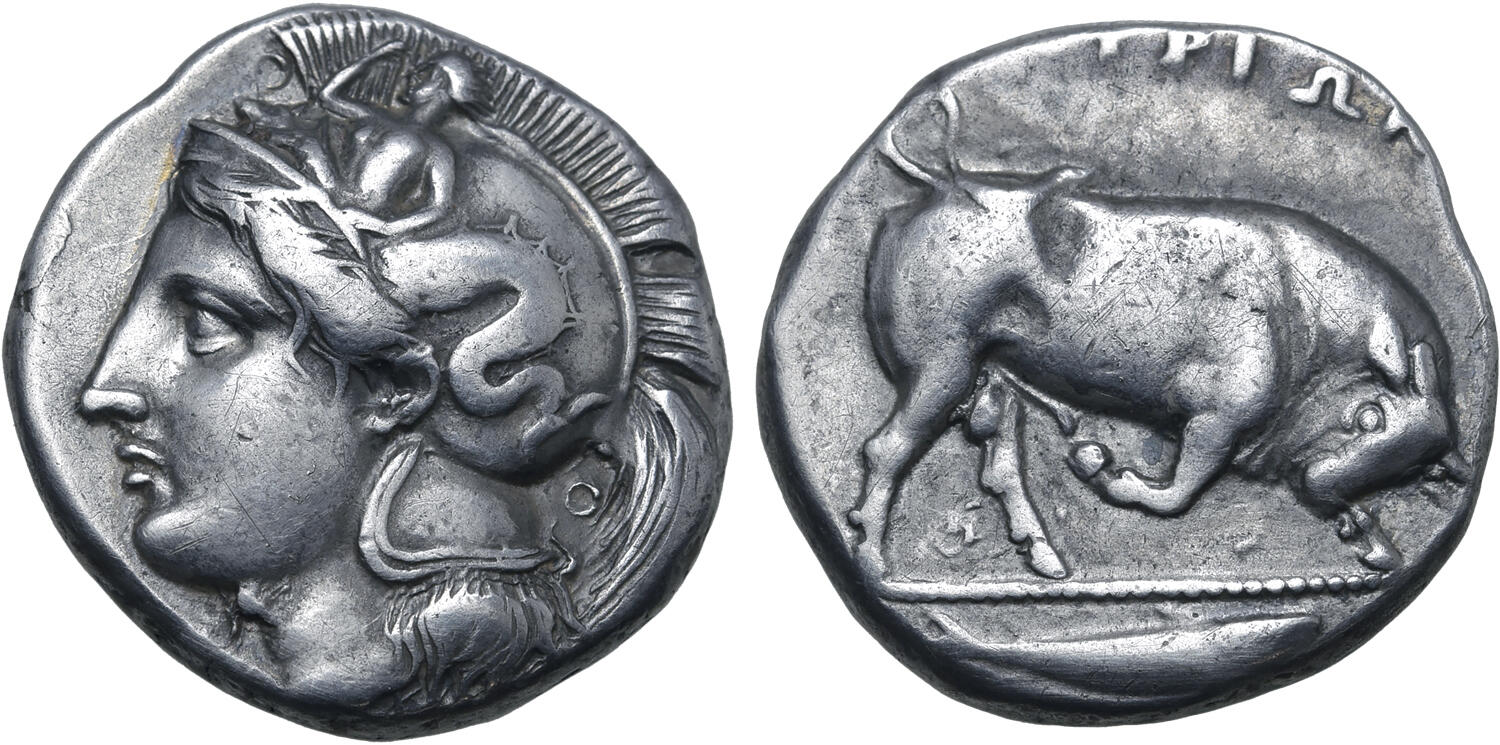Thurium, silver, distaters (400-281 BCE)
From SILVER
400 BCE - 281 BCE Silver 22,994 kg
Description
| ObverseInscription or printing placed on the obverse.: | Head of Athena right (sometimes left), wearing crested Attic helmet with Scylla. |
| ReverseInscription or printing placed on the reverse.: | ΘOYPIΩN (Greek).Bull charging to right, fish to right in exergue |
Mint and issuing power
| MintIdentifies the place of manufacture or issue of a numismatic object.: | Thurium | Ancient regionAncient region.: | Lucania | Modern countryModern country: Italy | AuthorityIdentifies the issuing power. The authority can be "pretended" when the name or the portrait of X is on the coin but he/she was not the issuing power. It can also be "uncertain" when there is no mention of X on the coin but he/she was the issuing power according to the historical sources: |
Chronology
| FromIdentifies the initial date in a range assigned in a numismatic context. | 400 BCE | toIdentifies the final date in a range assigned in a numismatic context.. | 281 BCE | PeriodTime period of the numismatic object.: Classical and Hellenistic |
Physical description
| MetalThe physical material (usually metal) from which an object is made.: | Silver |
Median weightMedian of the weights of numismatic objects (in grams). in grams | 15.70 | DenominationTerm indicating the value of a numismatic object. Examples: tetradrachm, chalkous, denarius.: | distater |
StandardStandard.: |
Image

AC 9 - Thurium, silver, distater, 400-281 BC.jpg [1]
References
| Die study referencePublication of the study: | Noe 19351Noe 1935 | ||
| Coin series referenceReference to coin series study: | Sear I2Sear I, n° 445-446, RQEMAC3RQEMAC, n° 9, HN Italy4HN Italy, n° 1803-1805, HGC 15HGC 1, n° 1254-57 | ||
| Coin series web referenceCoin series web references: | |||
Obverse dies distribution
| FrequencyFrequency of specimen in distribution. ᵖ | Number of obversesNumber of obverse dies. ᵖ (o) | % (o) | Number of coinsNumber of coins. (n) | % (n) | Die nameName(s) of the die(s). |
| 1 | 18 | 27.69 | 18 | 5.96 | A2, H12, H14, H22, J10, J12, J14, J18, J22, J30, J32, J34, M2, M4, M6, M16, N14, N16 |
| 2 | 10 | 15.38 | 20 | 6.62 | F32, F46, H2, H26, J6, J16, J20, J28, K14, M8 |
| 3 | 10 | 15.38 | 30 | 9.93 | B6, D14, H4, H6, J24, K8, K12, L8, M10, N6 |
| 4 | 3 | 4.62 | 12 | 3.97 | B8, C2, L4 |
| 5 | 2 | 3.08 | 10 | 3.31 | C4, J2 |
| 6 | 8 | 12.31 | 48 | 15.89 | F12, F38, H8, J26, K2, K4, K18, M14 |
| 7 | 4 | 6.15 | 28 | 9.27 | F28, F36, H24, N10 |
| 9 | 2 | 3.08 | 18 | 5.96 | D2, L2 |
| 10 | 1 | 1.54 | 10 | 3.31 | D8 |
| 11 | 2 | 3.08 | 22 | 7.28 | C6, H16 |
| 14 | 1 | 1.54 | 14 | 4.64 | G2 |
| 15 | 1 | 1.54 | 15 | 4.97 | H28 |
| 17 | 1 | 1.54 | 17 | 5.63 | F4 |
| 18 | 1 | 1.54 | 18 | 5.96 | B2 |
| 22 | 1 | 1.54 | 22 | 7.28 | F16 |
| Total | 65 of 65 | 100.01 | 302 of 302 | 99.98 |
Reverse dies distribution
no distribution is available
Quantification
| Number of obversesNumber of obverse dies. ᵖ (o) | 65 | Number of singletons (o1)The number of singleton coins. ᵖ | 18 |
| Number of reverse diesNumber of reverse dies. (r) | Number of coinsNumber of coins. (n) | 302 | |
| Coins per obverse dieNumber of coins per obverse die. (n/o) | 4.65 | Coins per reverse dieNumber of coins per reverse die. (n/r) | |
| Reverse per obverse ratioRatio of obverse dies divided by reverse dies. (r/o) | Percentage of singletons (o1)number of coins (n) divided by the number of singletons (o1) ᵖ | 27.69 % | |
| Original number of dies (O) (Carter 1983 formula)The estimation of the number of coins according to Carter 1983 ᵖ | 73.23 | Coins struck if 20,000 as average productivity per dieCoins made if the average productivity for obverses (according to Carter) is 20,000. ᵖ | 1,464,600 |
| Original number of dies (O) (Esty 2011 formula)The estimation of the number of coins according to the singleton formula in Esty 2011 ᵖ (O) | 82.83 | Survival rate if 20,000 as average productivity per dieSurvival rate if average productivity is 20,000. ᵖ | 0.00021 |
| Coverage (o = % of O) (Esty 1984 formula)Esty 1984 - coverage (% of O) ᵖ (o = % of O) | 94.04% | Die productivity if survival rate 1/2,000Average productivity if survival rate is 1/2,000. ᵖ | 8,247.99 |
| Weight of silver (in kg) if 20,000 coins per die (O = Carter formula)Carter 1983 * Median weight * 20000 (*10 if gold or electrum) ᵖ | 22,994 kg <br /> 22,994 kg | Die productivity if survival rate 1/5,000Average productivity if survival rate is 1/5,000. ᵖ | 20,619.96 |
Remarks